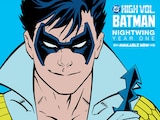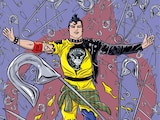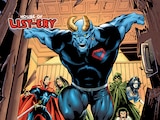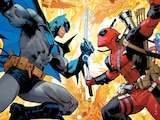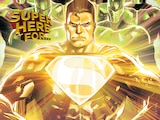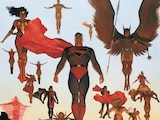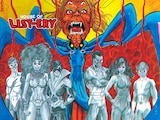It's Halloween and with David F. Sandberg's sequel to his excellent Shazam! now just several months away, I've been thinking about one of the lesser celebrated aspects of the first movie. The family flick is wonderful for a whole bunch of reasons: the inclusive cast, exciting plot, fresh take on superheroics and the blisteringly funny mix of action and adventure. But one of the things that really stood out to me and to plenty of parents is that Shazam!, aside from everything else, is legitimately scary.
For many of us growing up, the films that we loved were also pretty scary. Whether we’re talking about ’80s-era classics like Gremlins,The Neverending Story, The Dark Crystal, Ghostbusters, The Burbs; animated films like Watership Down, The Secret of NIMH or The Black Cauldron; or television shows like Are You Afraid of the Dark? and Goosebumps, we would cower around the TV getting the thrill of watching something fun and frightening. It's not a phenomenon that has necessarily been lost completely, but the cultural landscape has shifted enough that when the audience first sets eyes on Shazam!'s horrifying monsters, they manage to feel like something almost completely new and surprising.

For anyone who has forgotten, Shazam! centers on young Billy Batson who is chosen by the Wizard Shazam to wield the mighty powers of the gods Solomon, Hercules, Atlas, Zeus, Achilles and Mercury just by saying the magic word, which happens to be an acronym of all of those heroes' names. During the sequence where Billy gains his powers, we’re introduced to the Seven Deadly Sins. The Wizard has trapped the monsters in cartoonish and grotesque statues, but with the help of the man who once almost gained the same powers of Billy, the Sins will soon be free.
Conceptually, the Seven Deadly Sins as villains seems a little funny, and the act of translating them to the screen seems like an especially complex one. Yet Sandberg manages to do so in a way that's both appropriate and terrifying. Once the monsters are released from their prisons, we get to see them in their true forms: shifting, shadowy beings that feast on sins and those who have committed them...or at least whoever Sivana decides should be punished. Visually, the beasts sit somewhere between Gozer from Ghostbusters and the creatures from Silent Hill. They're menacing, scary and at times, brutally violent.

The Sins’ scenes are shocking, but believing that children can handle being scared is a large part of making stuff that appeals to them. Some of my most formative moviegoing memories are focused on the slight thrill of fear, the shiver of the unknown and the juxtaposition of the relatively safe environments in which I watched them. Film and fiction offer up a place to explore, whether it's worlds and spaces we would never usually encounter or experiences we will never have. It's also a place to test out our boundaries. Almost everyone has a visceral memory of the first fictional thing that truly scared them, and from there you can trace a path of whether you pursued that feeling again or avoided it as much as possible.
Aquaman hinted at a return to allowing children to feel fear within the safe constraints of a family film. Though it was only one sequence, the horrors of the Trench were chilling, monstrous, bloodthirsty creatures looming large over Arthur and Mera. With Shazam!, Sandberg (who like Aquaman’s James Wan, comes from a horror background) escalates that, making the Seven Deadly Sins a core part of the film, with viewers learning to fear their arrival every time we see Dr. Sivana.
The power in what Sandberg does so well, though, is balancing what to show and what to hide. We see the Sins demolish a room of businessmen during one particularly jaw-dropping scene and there's a surprising amount of implied violence, with a decapitation occurring early on, and a later massacre which is only seen through the misted glass doors. The use of shadows and lack of blood make it palatable while still utterly fear-inducing. It's a masterclass in understanding just how far to push the audience, and in trusting that often the imagination is far more effective at conceiving things that truly haunt us.

The Sins are an interesting play on the myths and stories that scare us. Here, the creatures of Christian morality tales take on the form of a child's nightmare—the monster who hides under the bed, so to speak. Because of that, Sandberg can also strike fear in the adults in the audience. To the children both in the film and watching, the Sins are powerful and evil beings with stomachs filled with teeth or sharp claws. But to the adults both on and off screen, they're a representation of a reckoning, their biblical meaning never forgotten.
It's this balance which gives Shazam! and its scary moments so much power. No matter who's on the other side of the screen, the film finds a way to both equally inspire and scare, which is something most family films have been lacking for a while now.
Shazam!, starring Zachary Levi, Asher Angel and Mark Strong, is now streaming on HBO Max. Want to learn more about Billy and his world? Just say the word! ...Er, by which we mean, click here.
Rosie Knight writes about comics, movies and TV for DC.com, Den of Geek, Nerdist and IGN and is the cohost of the X-Ray Vision podcast along with the Emmy Award-winning Jason Concepcion.





